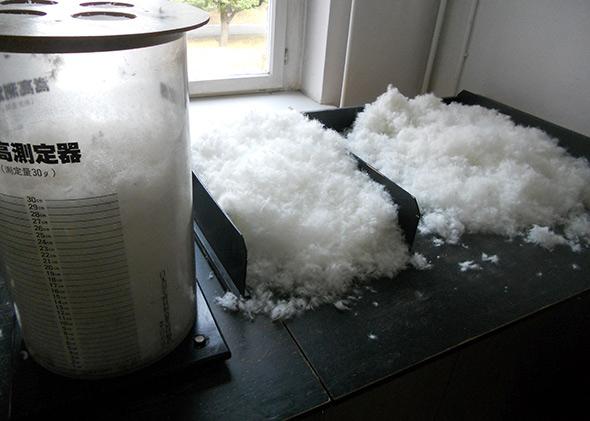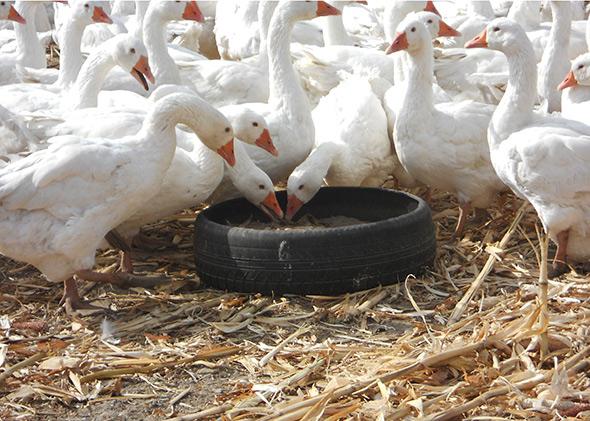There are more meatless, grass-fed, and cruelty-free alternatives for food, leather, and fur than ever before. And now the outerwear industry is spreading a wake-up call about down: The goose and duck feathers in our winter jackets and bedding can be more sinister than they seem.
Cruelty can happen early in manufacturers’ supply chains, and in recent years companies such as Patagonia and the North Face have invested money and time to work backward through their processes and create better accountability. Patagonia worked internally to develop the Traceable Down Standard, released last year to ensure that the origin and route of all of its down can be confirmed along with the quality of animal treatment at the farms it comes from. Similarly, the North Face worked with the nonprofit Textile Exchange to create the Responsible Down Standard, which also aims to prevent cruelty to ducks and geese. Industry standards for manufacturing ethical down never existed before, and the hope is that creating these protocols will motivate better oversight at every phase of down collection.
For both Patagonia and the North Face, awareness about the importance of supply chain regulation began in 2010 when Four Paws, an animal welfare organization, publicly criticized the companies’ audits of their suppliers.
“We have always visited our farms for quality issues and we required affidavits for animal welfare,” says Wendy Savage, Patagonia’s supply chain, social responsibility, and traceability manager. She says that when Four Paws confronted the company about potential cruelty issues, Patagonia decided to send a team of employees to Hungary, where the company’s supply chain was located at the time. “They discovered that our down came from the force-feeding industry,” Savage says. “We decided we had to do something to change that as quickly as possible. We also decided we had to come clean with our customers and let them know that Four Paws had raised an issue and we had confirmed that it was true.”
Down is harvested as a byproduct of the meat industry, and there are a number of ways that animals can suffer. Geese and ducks raised for slaughter go from a parent farm where they are laid to a hatchery, then a raising farm, and finally the slaughterhouse when they are 12 to 16 weeks old. These animals may be force-fed to make them fat and tender, especially if they are being raised for foie gras production. Ducks and geese that stay in the parent farm to produce eggs live four to five years. When they molt, farmers collect their down; but since they live for so long, there’s an economic temptation to live-pluck the birds—which is, needless to say, incredibly painful and distressing to them—so that they repeatedly grow new feathers and can contribute down throughout their lives.
To viscerally convey the cruelty of these practices, Patagonia worked with designer Geoff McFetridge to make this video. (It’s animated but still haunting.)
In August the Guardian described the dual existence of the Traceable Down and Responsible Down standards as a “down smackdown,” and certainly both Patagonia and Textile Exchange (which owns the Responsible Down Standard) are both working to make their documents the best and most rigorous they can be. As of its fall 2014 line, Patagonia is first to make all of its newly manufactured apparel with 100 percent traceable down; the North Face won’t reach this goal until 2017. But the Responsible Down Standard has provisions for audits of both industrial farms and collector-based chains—systems in which individuals who amass a relatively small amount of down can sell it at any interval to a local collector. (Patagonia says it is currently finalizing a revision of its standard that will address these types of chains.)

Courtesy of Patagonia
It seems that competition between the two standards is only serving to improve both of them; with each revision, their differences become less pronounced. Four Paws has noticed this convergence as well. In August, Nina Jamal, an international farm animal campaigner for the group, said that she felt Patagonia’s standard was stronger and in the lead. But now she says, “What we’re seeing is that the [Responsible Down] Standard is catching up and there might be points where it might even become stronger than the Patagonia standard.”
Patagonia, which made $575 million in 2013, is a smaller company than the North Face, which grossed $2 billion last year. And the outerwear industry in general is a relatively small player in total down consumption compared to bedding and hospitality companies. Adam Mott, the director of sustainability at the North Face, told Fortune last week that the outdoor industry uses just 1 percent of commercial down. But Anne Gillespie, director of industry integrity at Textile Exchange, says that companies like Patagonia and the North Face can still make a strong statement. “I think the outdoor industry punches well above its weight in terms of the impact,” she says. “There’s more of a branding association than there is with bedding.”
Gillespie adds that many more companies have committed to adopting the Responsible Down Standard. Textile Exchange announced earlier this month that 10 brands including Eddie Bauer, H&M, Marmot, and two large bedding companies are all on board. And Patagonia is working with groups such as the Outdoor Industry Association, European Outdoor Group, and German Sporting Goods Industry Association to spread their standard.
Additionally, clothing retailers approached Textile Exchange asking for standards to ensure ethical treatment of animals producing other products. Now the group is actively working on a wool standard and is in the early stages of starting an angora standard—rabbits can be live-plucked, too.
As Patagonia and the North Face work to improve their down standards and help them gain traction, it’s useful to look to Swedish outdoor products company Fjallraven, which has a story that mirrors Patagonia and the North Face’s in many ways. After receiving criticism about its down supply chain from Swedish animal rights organizations in 2009, the company worked on internal improvements to audit its suppliers at a much higher standard than previously. Unlike the other two brands, Fjallraven only sought to improve its own process and didn’t attempt to publish a public standard. Aiko Bode, Fjallraven’s chief sustainability officer, said that much of the company’s reforms are uniquely tailored to its specific supply partners; by operating in a relatively closed system, Fjallraven can exercise maximum control and oversight of the down that goes into its outdoor products.
But Bode cautioned that no matter how long a company spends on standards and guidelines, there is always more to explore and improve. For example, he says that Fjallraven didn’t consider animal transportation as a concern at first but eventually realized through site visits in China that there needed to be clear guidelines for transporting ducks and geese so they wouldn’t be stuffed into small cages or have their legs violently tied.
“We are continuously working on this, and it’s a process that probably will never stop,” Bode said. “It will never be ‘Now we are the perfect company; now we have the perfect supply chain.’ But this is triggering new ways of doing business.”
